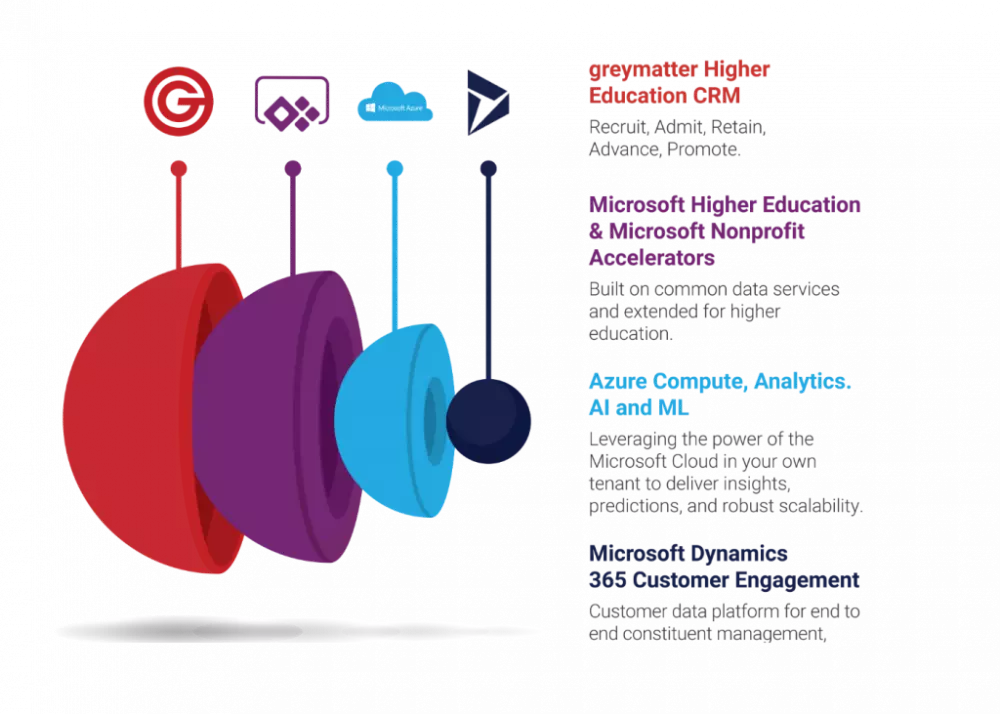
Overview
Athabasca University (AU), located 145 kilometres north of Edmonton, Alberta, Canada, has a long history of educational innovation, including 50 years’ specialization in distance and distribution learning as well as the introduction of the world’s first online MBA program in 1994. Founded in 1970, AU has since grown to over 1200 faculty and staff, currently serve a combined undergraduate and graduate population of over 40,000 students, and is one of only four comprehensive academic and research universities serving the 4.3 million residents within the province of Alberta.
With the addition in 2011 of Frequency Foundry’s flagship higher education Constituent Relationship Management (CRM) solution, greymatter, AU has moved towards providing complete flexibility and accessibility to online students, especially through greymatter’s functionality to improve upon institutional recruitment, admittance, and retention.
Built on top of Microsoft’s industry-leading business application platform, Microsoft Dynamics 365, greymatter not only captures constituent data from prospective students through to their alumni years but is unique in being the only full lifecycle CRM solution built specifically to serve higher education institutions. While Athabasca University chose to focus heavily on recruitment and retention requirements, AU also extended the solution to cover facilitation of payments for registration through a PCI-compliant payment gateway, corporate partner relationships, registration management, and automated marketing. Considering the breadth of functionality, it was clear to AU that greymatter was the correct fit, which would not only fit AU’s current needs but also scale to meet future demands.
The Challenges
Before the implementation of greymatter, Athabasca University experienced persistent process challenges with its approach and execution of recruiting new students. Despite being an innovative and creative institution, AU had used traditional approaches to recruitment, including newspaper print advertisements and manually collecting prospect student information. In contrast with their dedication to delivering innovative, technology-focused distance learning, AU’s traditional recruitment approach exposed several weaknesses, including the inabilities to:
- Capture multi-channel leads (inputs from social networks, school counsellors, academic and other administrative departments, student/alumni referrals, input from campus visits, integration with university’s webpages),
- Share data for lacking manual entry and maintenance of lead data in Excel spreadsheets,
- Analyze data for targeted communication and campaigns,
- Track donor and donation information, for lack of reliable methods,
- Interact between prospects or alumni with staff, for lack of dedicated portals,
- Ensure that prospects receive timely responses to inquiries, for lack of enforceable or repeatable follow-up processes, and
- Ensure data transfer when converting a prospect to an applicant, and continuity if trying to convert a prospect to an active student, alumnus, donor, or other discontinuous constituent types.
Additionally, Athabasca University had been using a legacy student information system (SIS), Banner, which created further difficulties for the university, including the inabilities to:
- Serve the data storage and communication needs of recruitment staff regarding prospective students,
- Customize the forms and workflows to cater to the needs of graduate admissions,
- Serve the needs of individual administrative and academic department’s initiative for closed-loop communication with current students,
- Meet the needs of program/course registration online fee payments for graduate programs, and
- Integrate appointment scheduling needs with the student web-portal.
These inabilities led to the disfunction of organizational data silos, as individual departments applied their own disparate, non-integrated IT systems, tools, and solutions to address their specific needs. These silos not only hoarded data from each other, but also from AU’s SIS, which acted as the system of record for student data.
The Solution
Athabasca University required an enterprise-wide implementation of a CRM solution that would meet the needs of student recruitment and retention.
Athabasca University’s long-term vision was a CRM that would cover the entire student lifecycle, beginning with an enterprise-wide implementation that would improve recruitment outcomes and retain an exceptional percentage of international students through the advancement of advisory and counselling processes. An additional aim of AU’s initiative was to solve data siloing with a CRM that could meet the requirements of individual departments or faculties.
- Banner ERP, traditionally used for application processing, student information, and financial services,
- Intermedia multi-channel call center platform,
- Moodle Learning Management System (LMS),
- Raiser’s Edge donation management system, and
- Athabasca University’s Central Authentication System (CAS).
The recruitment team members required mobile extensions to conveniently enter lead or prospect information. Examples of recruitment team requirements included:
- Conducting recruitment events, such as during high-school visits,
- Sending mass automated marketing campaign emails and newsletters & tracking ROI, and
- Tracking the status of applications.
To meet the requirements of student retention, the solution needed to include:
- Tracking of applications and status, and the merging of constituent records,
- Tracking of course enrollment, transfer credits, payments, and grades, and
- Initiating advising services to students in academic and financial distress.
In 2011, Frequency Foundry successfully implemented the greymatter CRM solution at Athabasca University with the following components:
- Prospect relationship management for recruitment (for information center, recruitment, marketing, and enrolment services),
- Ticketing/service request system (campus-wide usage by all administrative departments),
- Knowledge base system (campus-wide usage by all administrative departments),
- Student exam and appointment scheduling, and
- Integration with Raiser’s Edge donation management system and the other legacy platforms.
The implementation of greymatter for Athabasca University would be Frequency Foundry’s first foray into higher education CRM solutions. Since then, greymatter has grown substantially in roadmap development and has been implemented in 16 higher education institutions, all of which we proudly maintain development, expansion, and service support with, including Athabasca, in support of their own roadmap requirements across all faculties and administrative departments.
The Technology
greymatter is built on the Microsoft Dynamics 365 Customer Engagement Platform and Common Data Services and relies on Azure services for infrastructure, platform, and software. The solution sits within the customer’s Azure and Office 365 tenants and brings together the Power Platform, Azure AI+ML, Productivity, and business apps on the common data service. . It has been technically validated and certified for AppSource and is the only solution built on both Microsoft’s Higher Education and Nonprofit Accelerators.
Foundry is the only vendor to combine two of Microsoft’s industry solutions using the Common Data Services model, which ensures that greymatter remains standards-driven and standards-based to allow for ease of integration.

Results
The following list provides some key outcomes from the greymatter implementation at Athabasca University. The solution:
- Provided seamless integration through single sign-on to greymatter portals (web extensions to CRM),
- Provided a dedicated portal for prospects, applicants, students, and alumni,
- Provided online payment facility for graduate students and corporate non-program students, and
- Acted as a common platform for ticketing/service request processes and knowledge system.
After three years of successful usage, the client expanded the greymatter platform to add the following modules:
- Registration and online payment for corporate clients.
- PCI compliance for faculty of business for course registration and online payment.
- Faculty of business online application form and payment for MBA, DBA (doctoral) and diploma program.
- Marketing autonomation for numerous campaigns.
Since implementation, greymatter has helped to dissolve departmental data silos at Athabasca University by providing a centralized system from which all data can be accessed by multiple users according to their user permissions.
greymatter is currently used by almost all administrative and academic departments in AU, who are able to leverage the ever-growing number of functions related to relationship management that are consistently being added to the CRM system, which is due to the flexible framework that the Dynamics platform offers. As a result, there has been a significant increase in the rates of enrollment and student retention at Athabasca University after the deployment of greymatter.


